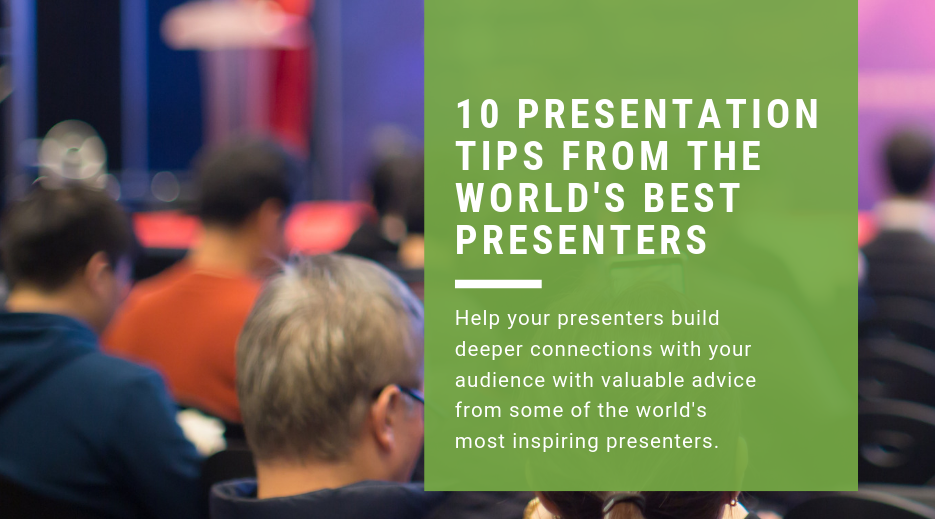10 Presentation Tips from the World's Best Presenters
June 25, 2019 •Array Team

We frequently hear comments like this from meeting and event planners seeking presenter tips: "My presenters are no Steve Jobs. I have to fight to even get them to include polling questions.” It's a challenge that plagues us all. A speaker is an expert in his or her field but not necessarily an expert at delivering a presentation. They may not know how to build a compelling story to engage the audience. All too often, they provide their slide decks at the last minute with no plan to achieve engagement. This puts everyone in a difficult, uncomfortable position. Especially you, the planner. Why bother pushing your presenters to improve their delivery?
In short, it's a win for everyone. When an inspiring presenter delivers a compelling story, something magical happens. It transforms the  energy in the room in a way that it's almost palpable. The audience becomes involved and invested in what they are learning. The speakers win by teaching and inspiring the audience. The stakeholders win by delivering an impactful meeting.
energy in the room in a way that it's almost palpable. The audience becomes involved and invested in what they are learning. The speakers win by teaching and inspiring the audience. The stakeholders win by delivering an impactful meeting.
Now, let's pause for a second and get real. You've devoted a lot of time, resources, and planning to bring your audience together (in-person or virtually) for a phenomenal meeting experience. Do you want to leave your speakers' presentations to chance?
Of course not. That means it's up to you to help them deliver their content in the most effective way.
Before we get to that, what makes a great presenter? Are they "born that way" or is something else going on? It turns out, even Steve Jobs was not born a great presenter. He needed some presenter tips to start and he practiced. A lot. Do you know what else he did? He watched other great presenters. He watched them, learned from them, and then he incorporated their strategies into his own presentation.
There is one common thing that all great presenters do. They captivate and forge deep emotional connections with their audience. Your speakers can do this too, with a little nudge from you.
To get you started, we've compiled a few valuable presenter tips from some of the world's most inspiring presenters. Watch them, learn from them and don't be afraid to share these with your own speakers. Applying just a few can have a huge impact and help them build a deeper connection with your audience.
1: Take the Audience on a Journey
Nancy Duarte is an author and expert on communications and persuasion who helps corporations bring storytelling into their communications strategies. She shares some of the most basic and powerful tenets of a great presentation. An effective presentation begins with an idea. Each presentation should have a great beginning, middle and end. From Aristotle to Martin Luther King, Jr., Duarte argues that the best talks detail the present state, a vision of what could be, and the journey to get there.
2: Dazzle them with Beautiful Data
Data journalist and designer David McCandless understands that data can be used to tell a story. Data can be visualized in more ways than the typical charts and graphs. Data visualization and design can provide context, meaning and importance for presentations, delivering information in a way that resonates with the audience. Making data beautiful can help your speakers connect people to the ideas they want to get across and delivers the messages memorably.
3: Make the Audience Anticipate the Big Reveal
In his first speech as Apple CEO, Time Cook starts with a laid-back, quiet presentation, welcoming people into the company’s “home.” He teases the audience with what he’s going to reveal – new mobile technology, hardware and applications. He leaves the audience hungry, at the edge of their seats, eager to find out what Apple has in store. When taking your audience on a journey, encourage your presenters to make the buildup compelling and in harmony with what they’re revealing. Cook was, of course, replacing Steve Jobs and had big shoes to fill. Product reveals have become a trademark of Apple for one important reason: They are effective.
4: Encourage People to Find Meaning
Amazon CEO Jeff Bezos conveys the power of motivation and giving people meaning to the work they do. In this clip, Bezos talks about how to focus work and gratitude on things that matter most, recognizing that it takes passion, hard work and persistence to succeed. What Bezos does so well is reinforce that success means believing in what you do and its impact on others. What a wonderful message to communicate to an audience!
5: Bring a New Approach to the Familiar
Biotechnology often evokes images of scientists in lab coats wearing safety glasses. That’s not what Keira Havens, CEO of Revolution Bioengineering, is about. In her Ted Talk, she talks about the beauty of biotechnology. Her approach is a refreshing one, delving into the world of genetic modifications, respect for living organisms and innovation. She reinforces both the “biology” and “technology” aspects of her field. It’s a fascinating approach that leaves her audience intrigued by how she brings an artistic approach that can change the way people think about her field.
6: Remember What You Say Without Saying Anything
Psychology Professor Allan Pease is an expert on relationships and human communication. He tells his audience here about how quickly we create impressions of those we meet. A lot of those impressions are formed in the first four minutes and can be shaped by something as seemingly minor as a handshake. Pease emphasizes how the same words can be interpreted very differently based on nothing more than a change in hand gestures. Imagine your presenters being so self-aware that they understand how their non-verbal movements can shape how well their messages are received.
7: Don’t Forget that it Starts with a Great Idea
Chris Anderson is the leader of TED. He’s heard hundreds of speakers and helped them create great talks. He believes there’s one common ingredient to a great talk. He says that the speaker’s role is to deliver a gift to the audience. The gift is a “strange and beautiful object that we call an idea.” One idea is all it takes to connect speakers with their audience. Anderson urges speakers to focus on just one idea that is a through-line throughout the talk and make people care about the idea by using powerful questions and language that spark their curiosity.
8: Be Genuine
For several years, Ryan has been one of the most-followed influencers on YouTube. What does he do? He plays with toys. Ryan’s Toy Review features the precocious youngster opening up toys, playing with them and sharing his thoughts on how fun they are. Sure, he has some help from his mom along the way, but Ryan is genuine. He acts like a kid, states what he’s feeling and will relate to kids and their parents.
9: Tell an Emotional Story
Roger Stein’s Ted Talk is all about pharmaceuticals. But instead of the challenges of being a pharma startup or the stats about drug trials, he makes it human. He tells the story of his father’s treatment for lung cancer. Telling his own story drives home the impact of the ideas he seeks to convey.
10: Listen for Understanding
When addressing conflict or disagreement from audience members, we can all take a lesson from Oprah Winfrey. Her ability to make every person feel heard is one of the reasons she is so admired by audience members, far and wide. She emphasizes how active listening makes a person feel heard and valued by the speaker, even if there are hundreds or thousands of others in the audience.
There you have it. Stories, ideas, body language, and authenticity are just a few strategies that can help your presenters connect with and engage your audience. And that's just the beginning. When your presenters take advantage of interactive meeting technologies, it can speed up the creation of those valuable connections.
At Array, we provide technology that engages live and virtual audiences in effective and innovative ways. To learn more, contact us.


